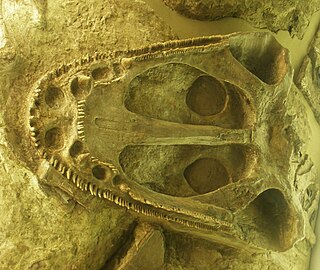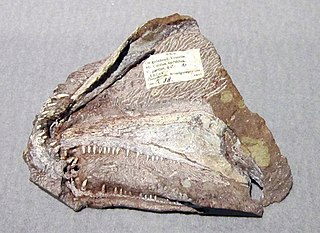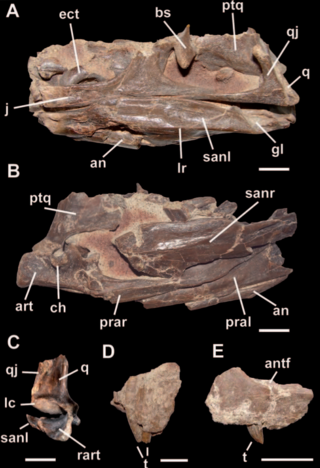
The ulna or ulnal bone is a long bone found in the forearm that stretches from the elbow to the wrist, and when in anatomical position, is found on the medial side of the forearm. That is, the ulna is on the same side of the forearm as the little finger. It runs parallel to the radius, the other long bone in the forearm. The ulna is longer and the radius is shorter, but the radius is thicker and the ulna is thinner. Therefore, the ulna is considered to be the smaller bone of the two bones in the lower arm. The corresponding bone in the lower leg is the fibula.

The humerus is a long bone in the arm that runs from the shoulder to the elbow. It connects the scapula and the two bones of the lower arm, the radius and ulna, and consists of three sections. The humeral upper extremity consists of a rounded head, a narrow neck, and two short processes. The body is cylindrical in its upper portion, and more prismatic below. The lower extremity consists of 2 epicondyles, 2 processes, and 3 fossae. As well as its true anatomical neck, the constriction below the greater and lesser tubercles of the humerus is referred to as its surgical neck due to its tendency to fracture, thus often becoming the focus of surgeons.

A snake skeleton consists primarily of the skull, vertebrae, and ribs, with only vestigial remnants of the limbs.

Masiakasaurus is a genus of small predatory noasaurid theropod dinosaurs from the Late Cretaceous of Madagascar. In Malagasy, masiaka means "vicious"; thus, the genus name means "vicious lizard". The type species, Masiakasaurus knopfleri, was named after the musician Mark Knopfler, whose music inspired the expedition crew. It was named in 2001 by Scott D. Sampson, Matthew Carrano, and Catherine A. Forster. Unlike most theropods, the front teeth of M. knopfleri projected forward instead of straight down. This unique dentition suggests that they had a specialized diet, perhaps including fish and other small prey. Other bones of the skeleton indicate that Masiakasaurus were bipedal, with much shorter forelimbs than hindlimbs. M. knopfleri was a small theropod, reaching 1.8–2.1 m (5.9–6.9 ft) long and weighing 20 kg (44 lb).
This glossary of ichthyology is a list of definitions of terms and concepts used in ichthyology, the study of fishes.

Ventastega is an extinct genus of stem tetrapod that lived during the Upper Fammenian of the Late Devonian, approximately 372.2 to 358.9 million years ago. Only one species is known that belongs in the genus, Ventastega curonica, which was described in 1996 after fossils were discovered in 1933 and mistakenly associated with a fish called Polyplocodus wenjukovi. ‘Curonica’ in the species name refers to Curonia, the Latin name for Kurzeme, a region in western Latvia. Ventastega curonica was discovered in two localities in Latvia, and was the first stem tetrapod described in Latvia along with being only the 4th Devonian tetrapodomorph known at the time of description. Based on the morphology of both cranial and post-cranial elements discovered, Ventastega is more primitive than other Devonian tetrapodomorphs including Acanthostega and Ichthyostega, and helps further understanding of the fish-tetrapod transition.

Anatosuchus is an extinct genus of notosuchian crocodylomorph discovered in Gadoufaoua, Niger, and described by a team of palaeontologists led by the American Paul Sereno in 2003, in the Journal of Vertebrate Paleontology. Its duck-like snout coincidentally makes it resemble a crocoduck, an imagined hybrid animal with the head of a crocodile and the body of a duck.

Tristichopterus, with a maximum length of sixty centimetres, is the smallest genus in the family of prehistoric lobe-finned fish, Tristichopteridae that was believed to have originated in the north and dispersed throughout the course of the Upper Devonian into Gondwana. Tristichopterus currently has only one named species, first described by Egerton in 1861. The Tristichopterus node is thought to have originated during the Givetian part of the Devonian. Tristichopterus was thought by Egerton to be unique for its time period as a fish with ossified vertebral centers, breaking the persistent notochord rule of most Devonian fish but this was later reinspected and shown to be only partial ossification by Dr. R. H. Traquair. Tristichopterus alatus closely resembles Eusthenopteron and this sparked some debate after its discovery as to whether it was a separate taxon.

Mastodonsauridae is a family of capitosauroid temnospondyls. Fossils belonging to this family have been found in North America, Greenland, Europe, Asia, and Australia. The family Capitosauridae is synonymous with Mastodonsauridae.

Dissorophus (DI-soh-ROH-fus) is an extinct genus of temnospondyl amphibian that lived during the Early Permian Period about 273 million years ago. Its fossils have been found in Texas and in Oklahoma in North America. Its heavy armor and robust build indicate Dissorophus was active on land, similar to other members of the clade Dissorophidae that are known from the Late Carboniferous to the Early Permian periods. Dissorphus is distinguished by its small body size, disproportionately large head and short trunk.

Heleosaurus scholtzi is an extinct species of basal synapsids, known as pelycosaurs, in the family of Varanopidae during the middle Permian. At first H. scholtzi was mistakenly classified as a diapsid. Members of this family were carnivorous and had dermal armor, and somewhat resembled monitor lizards. This family was the most geologically long lived, widespread, and diverse group of early amniotes. To date only two fossils have been found in the rocks of South Africa. One of these fossils is an aggregation of five individuals.

Laganosuchus is an extinct genus of stomatosuchid crocodyliform. Fossils have been found from Niger and Morocco and date back to the Upper Cretaceous.

In jawed vertebrates, the mandible, lower jaw, or jawbone is a bone that makes up the lower – and typically more mobile – component of the mouth.

Ymeria is an extinct genus of early stem tetrapod from the Devonian of Greenland. Of the two other genera of stem tetrapods from Greenland, Acanthostega and Ichthyostega, Ymeria is most closely related to Ichthyostega, though the single known specimen is smaller, the skull about 10 cm in length. A single interclavicle resembles that of Ichthyostega, an indication Ymeria may have resembled this genus in the post-cranial skeleton.

Bicentenaria is an extinct genus of carnivorous coelurosaurian theropods which lived during the early Late Cretaceous (Cenomanian) Candeleros Formation of Argentina. It contains the type species, B. argentina.
This glossary explains technical terms commonly employed in the description of dinosaur body fossils. Besides dinosaur-specific terms, it covers terms with wider usage, when these are of central importance in the study of dinosaurs or when their discussion in the context of dinosaurs is beneficial. The glossary does not cover ichnological and bone histological terms, nor does it cover measurements.
Sigournea is a genus of stem tetrapod from the Early Carboniferous. The genus contains only one species, the type species Sigournea multidentata, which was named in 2006 by paleontologists John R. Bolt and R. Eric Lombard on the basis of a single lower jaw from Iowa. The jaw came from a fissure-fill deposit of the St. Louis Limestone that was exposed in a quarry near the town of Sigourney and dates to the Viséan stage, making it approximately 335 million years old. Bolt and Lombard named the genus after Sigourney. The species name multidentata alludes to the many teeth preserved in the jaw. The jaw, which is housed in the Field Museum and cataloged as FM PR 1820, curves strongly downward but was probably straight to begin with, having been deformed by the process of fossilization after the individual died. Rooted in the dentary bone along the outermost edge of the jaw are 88 small, pointed marginal teeth. An additional row of even smaller teeth runs along the coronoids, three bones positioned lengthwise along the lower boundary of the dentary on the inner surface of the lower jaw. Bolt and Lombard were able to classify Sigournea as an early member of Tetrapoda based on the presence of bone surfaces covered in pits and ridges, a single row of dentary teeth, a jaw joint that faces upward, and an open groove for a lateral line along the outer surface of the jaw, and on the absence of teeth on the prearticular bone or enlarged fangs on the coronoids. Sigournea differs from other stem tetrapods in having several holes within a depression called the exomeckelian fenestra on the inner surface of the jaw.

Scutarx is an extinct genus of Aetosauriformes, most commonly regarded by its species name Scutarx deltatylus. Scutarx lived around 230 million years ago during the Carnian and Norian stage of the Late Triassic. Scutarx are “medium sized” paramedian osteoderms belonging to the clade Aetosauria, a heavily armored and more herbivorous cousin of crocodiles.

Qilinyu is a genus of early placoderm from the late Silurian of China. It contains a single species, Qilinyu rostrata, from the Xiaoxiang fauna of the Kuanti Formation. Along with its contemporary Entelognathus, Qilinyu is an unusual placoderm showing some traits more similar to bony fish, such as dermal jaw bones and lobe-like fins. It can be characterized by adaptations for a benthic lifestyle, with the mouth and nostrils on the underside of the head, similar to the unrelated antiarch placoderms. The shape of the skull has been described as "dolphin-like", with a domed cranium and a short projecting rostrum.

Manubrantlia was a genus of lapillopsid from the Early Triassic Panchet Formation of India. This genus is only known from a single holotype left jaw, given the designation ISI A 57. Despite the paucity of remains, the jaw is still identifiable as belonging to a relative of Lapillopsis. For example, all three of its coronoid bones possessed teeth, the articular bone is partially visible in lateral (outer) view, and its postsplenial does not contact the posterior meckelian foramen. However, the jaw also possesses certain unique features which justify the erection of a new genus separate from Lapillopsis. For example, the mandible is twice the size of any jaws referred to other lapillopsids. The most notable unique feature is an enlarged "pump-handle" shaped arcadian process at the back of the jaw. This structure is responsible for the generic name of this genus, as "Manubrantlia" translates from Latin to the English expression "pump-handle". The type and only known species of this genus is Manubrantlia khaki. The specific name refers to the greenish-brown mudstones of the Panchet Formation, with a color that had been described as "khaki" by the first British geologists who studied the formation.























